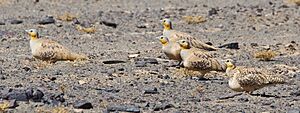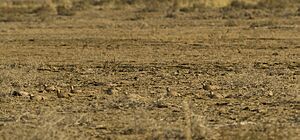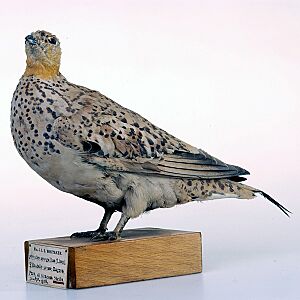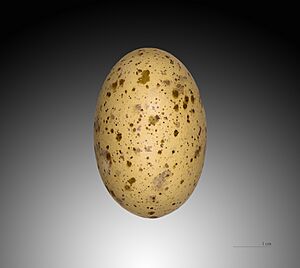Spotted sandgrouse facts for kids
Quick facts for kids Spotted sandgrouse |
|
|---|---|
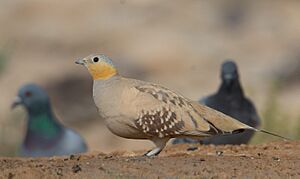 |
|
| male | |
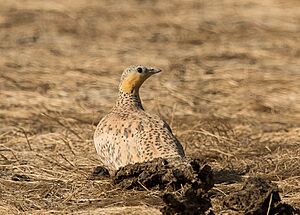 |
|
| female | |
| Conservation status | |
| Scientific classification | |
| Genus: |
Pterocles
|
| Species: |
senegallus
|
The spotted sandgrouse (Pterocles senegallus) is a type of bird that lives on the ground. It belongs to the family Pteroclidae. You can find these birds in dry areas of northern and eastern Africa. They also live across the Middle East and parts of Asia, reaching as far as northwest India.
Spotted sandgrouse are social birds that are active during the day. Small groups look for seeds and other plant bits on the ground. They fly to a waterhole once a day to drink. During the time they lay eggs, pairs build nests away from each other. They lay their eggs in a small dip in the stony ground. The baby birds leave the nest soon after they hatch. They eat dry seeds. The male bird helps them get water by soaking his belly feathers at the waterhole. The International Union for Conservation of Nature says the spotted sandgrouse is a species of "least concern." This means it is not currently at risk of disappearing.
Contents
About the Spotted Sandgrouse
The spotted sandgrouse grows to be about 33 centimeters (about 13 inches) long.
Male Sandgrouse
The male bird has a small reddish-brown patch on the back of its head. A light grey band goes around this patch, extending to its beak and neck. Its chin, neck, and throat are orange, and its chest is grey. The upper parts of its body are pinkish-grey. Its flight feathers are dark, and it has dark spots on its wings, tail, and lower belly. The main wing feathers are light with dark edges. This helps tell them apart from the crowned sandgrouse, which has completely dark main wing feathers.
Female Sandgrouse
The female also has an orange throat area. However, her feathers are generally duller than the male's. Her body is greyish-brown with many small dark spots. She also has dark patches on her wings, tail, and lower belly. Both male and female birds have longer central tail feathers. But they are not as long as those of the pin-tailed sandgrouse. When a spotted sandgrouse flies overhead, you can see a dark stripe on its belly.
Where Do Spotted Sandgrouse Live?
The spotted sandgrouse lives in North Africa and the Middle East.
African Homes
In Africa, you can find them in Morocco, Algeria, Tunisia, Libya, Sudan, Egypt, Eritrea, Somalia, Ethiopia, Djibouti, Mali, Mauritania, Chad, and Niger.
Middle East and Asia Homes
In the Middle East, they live in Oman, Saudi Arabia, Israel, Jordan, Syria, Iran, Iraq, and Afghanistan. Their home range stretches as far as Pakistan and northwest India. For example, in 2016, about a hundred birds arrived in Kutch, India, after 19 years. Sometimes, they are seen in places like Italy, the United Arab Emirates, and Turkey. These are places they do not usually live.
Their Habitat
Spotted sandgrouse live in deserts and dry, open countryside. They usually stay in one area. However, some groups might move around locally. We do not know the exact number of these birds. But their population seems steady. They are common across their wide home range. The IUCN Red List of Threatened Species lists them as a species of "least concern."
Daily Life and Habits
The spotted sandgrouse flies very fast, flapping its wings quickly. Its call sounds like a musical "queeto-queeto." This sound helps tell it apart from other sandgrouse birds that look similar.
Food and Foraging
Spotted sandgrouse are ground birds. They eat seeds and other plant parts they find among the dry plants in their desert home. During the breeding season, they are mostly alone. But at other times of the year, they live in groups. After a storm brings new green plants, flocks move to new feeding areas. In the Sahara Desert, these birds really like a certain type of spurge plant. They eat a lot of it until the leaves dry out. Then, they go back to eating their usual diet of seeds. Many seeds are on the desert floor. They stay in a sleeping state until it rains.
Staying Safe
These birds are very careful and get scared easily. Their main enemy is the lanner falcon. This falcon flies fast just above the ground and can catch birds that are not paying attention. The sandgrouse have a clever plan: one bird flies high up. If it sees a falcon coming, it makes a warning call. The other sandgrouse then freeze. Their camouflage is so good that the falcon often cannot see them and flies away.
Daily Water Trips
Sandgrouse need to fly to a drinking hole every day. This waterhole might be many kilometers from where they eat. They land a short distance from the water. Here, they also have a lookout system. This is because besides falcons, other animals like mammals might be hiding nearby. Also, nomads might bring their animals to drink there. When it is safe, the lookout bird makes another special call. Then, all the other birds go to the water. They drink all the water they need in about fifteen seconds.
Staying Cool and Safe at Night
The trip to the waterhole happens around dawn when the air is cool. Later in the day, the air can get hotter than 50 degrees Celsius (122 degrees Fahrenheit). During these hot times, the birds are not active. They can also make their bodies better at blocking heat when the air is hotter than they are. When it is very hot, they also flutter their throats and open their mouths to cool down.
At night, several groups of sandgrouse join together. They fly far into the rocky desert, away from any plants. Each bird makes a small, shallow sleeping spot by moving from side to side. There are no jerboas or other small mammals in these empty areas. So, foxes and jackals do not wander there at night, and the birds are safe.
Life Cycle and Family Life
In the Sahara, spotted sandgrouse lay eggs during the hottest part of summer. They nest on a stony desert plain.
Nesting
When choosing a nest spot, the female makes several test hollows. Then she picks one. The most important thing seems to be how porous (spongy) the rock underneath is. Spongy rock does not get as hot in the sun. This makes a cool place for the nest. It is also good to have one or two "cover stones" nearby. These stones attract dew (water drops) at night because they are dense. This moisture drains into the soil and is soaked up by the porous rock. This helps keep the nest cool during the day.
The nest is a shallow dip in the ground with no soft material inside. The female lays two, sometimes three, eggs. The eggs are long ovals. They are buff-colored with grey and brown blotches and speckles. Their color and shape make them hard to see among the pebbles around them. Both parents sit on the eggs to keep them warm. Their camouflage colors make them almost invisible when they are on the nest. The eggs hatch after about 20 days.
Raising Chicks
The young birds are precocial. This means they are already covered in soft down feathers when they hatch. Soon after hatching, the female leads the chicks to one of the many dry riverbeds (called wadis) that cross the plains. There, she teaches them to pick up and eat seeds. It takes four or five weeks before they grow their flight feathers and can fly.
Meanwhile, the male bird solves the problem of getting water to the chicks. He has special, very absorbent down feathers on his belly. When he is at the waterhole, he dips himself in the water. His feathers soak up enough water for the chicks until the next day. When he leaves the waterhole with his wet feathers, the male makes a repeated high-pitched "queet - queet - queet" call. When the female and chicks hear him coming, they call back. This way, the male can find his family even if they have moved from the nest. When he arrives, he stands tall and raises his wings. This shows off his wet belly feathers. This is the signal for the chicks to come closer. They stand under him with their beaks pointing up and drink the water from his feathers.
Protecting the Family
If danger comes, the chicks crouch under a plant or anything that offers cover. Their spotted brown down feathers blend into the desert. The parents are very watchful to protect their family. If a jackal comes near, an adult gives a warning cry. All the birds then crouch down and freeze. Usually, the enemy does not notice them and walks by. If the danger gets too close, one of the parents tries to trick it. The parent flaps along the ground, pretending to be hurt and helpless. Once the jackal has been led far enough away, the adult "recovers" and flies off. After three or four days, the chicks can be left alone while both parents visit the waterhole. The chicks can guide them back with their "queet - queet" cries.



